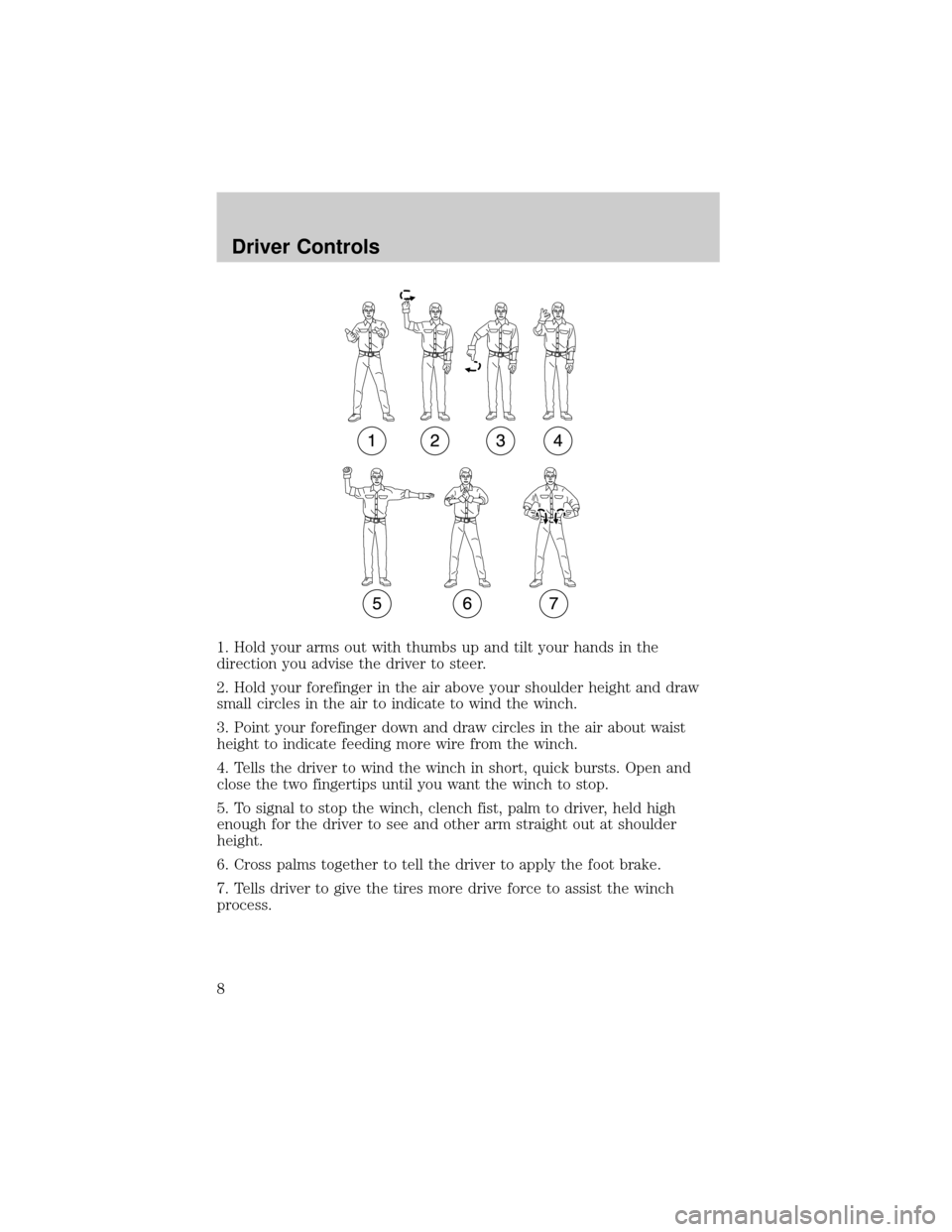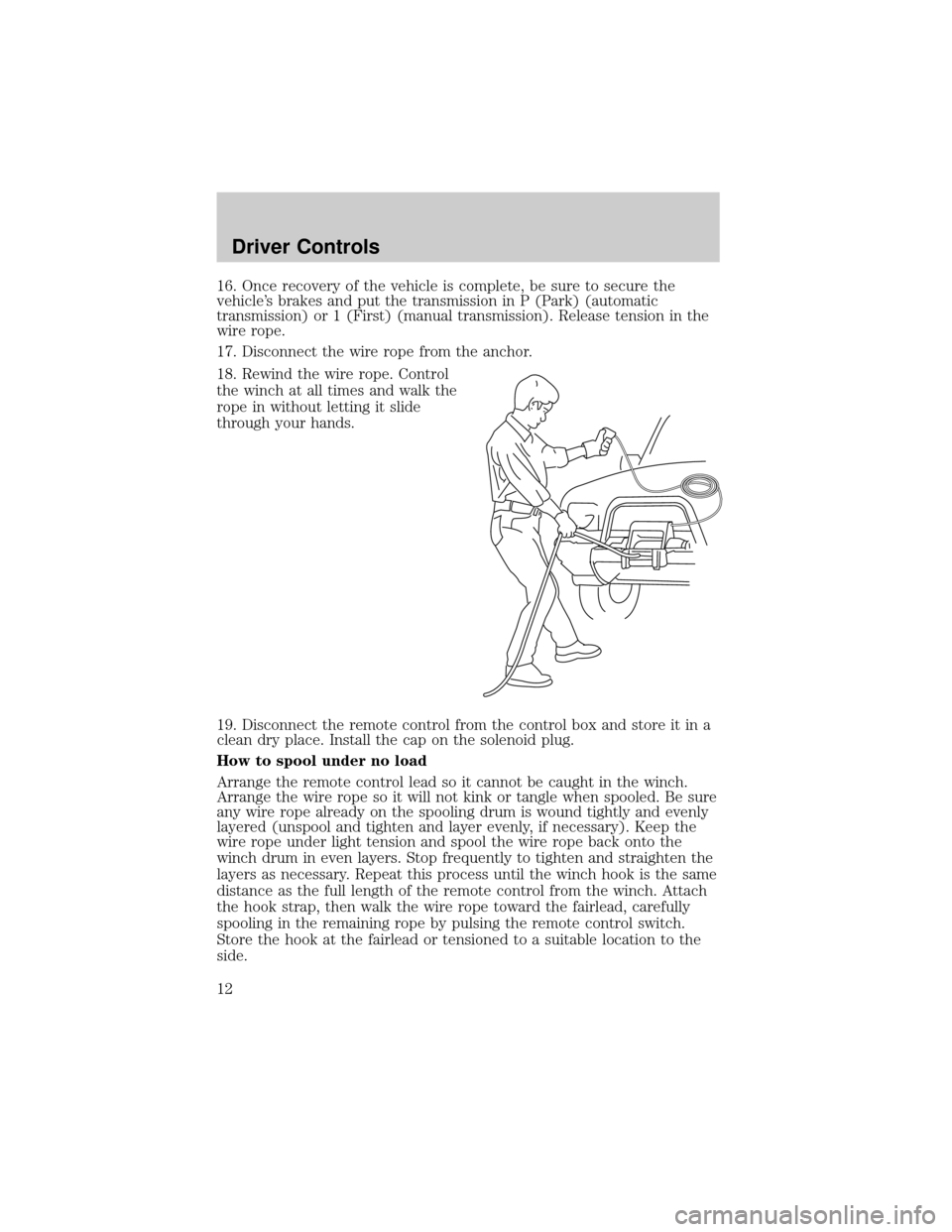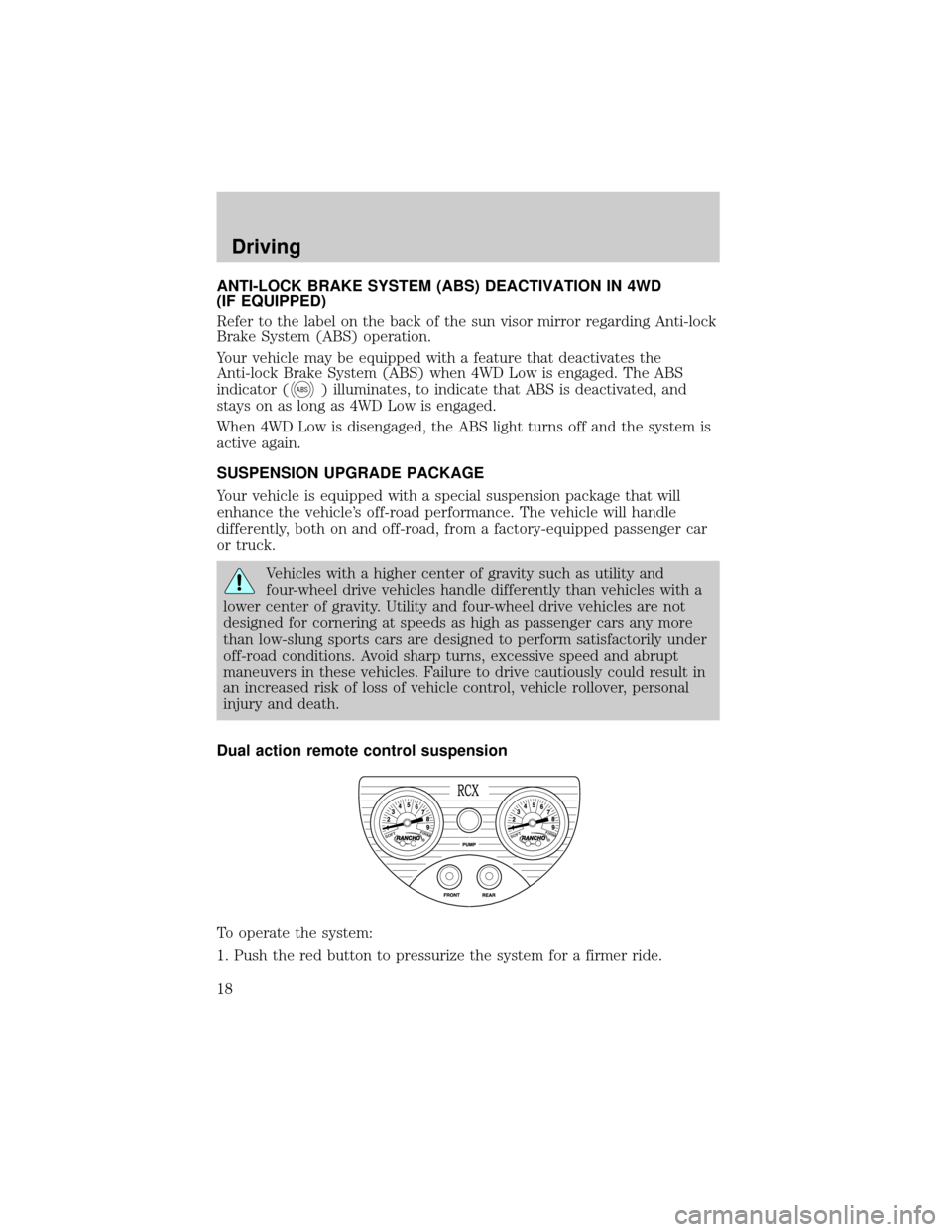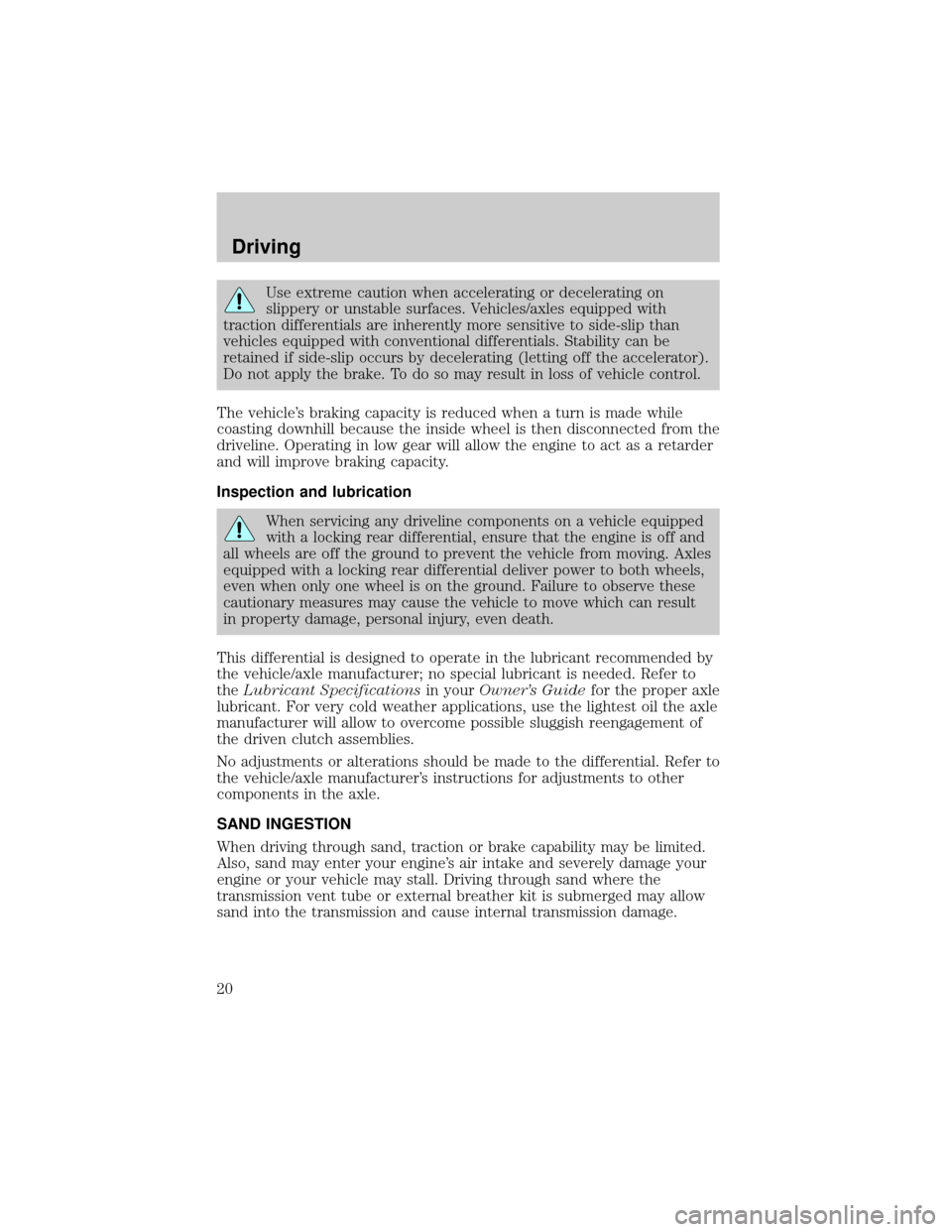2007 FORD SUPER DUTY brake
[x] Cancel search: brakePage 4 of 28

Familiarize yourself with the winch and each of its components:
1.Motor:Typically powered by vehicle's battery. Provides power to the
gear mechanism which turns the drum to wind the wire rope.
2.Winch drum:Driven by the motor and drive train. Drum direction can
be changed by using the remote control.
3.Wire rope:Wrapped around the winch drum and fairlead, the wire
rope is looped off at the end to accept the hook's clevis pin. When the
rope is being reeled in under motor power, it is being ªpowered inº.
When the wire rope is being reeled out under motor power, it is being
ªpowered outº. ªPowering outº is different than ªfreespooling outº which
refers to the wire rope being pulled out by hand with the clutch
disengaged.
4.Fairlead:Acts as a guide for the wire rope when using the winch at
an angle. Minimizes damage to the wire rope while it goes through the
winch mount or bumper.
5.Gear train:Converts winch motor power into pulling force.
6.Braking system:Prevents winch from paying out line, which in turn
holds the vehicle in place. The brake is automatically applied to the
winch drum when the motor is stopped and there is load on the rope.
Driver Controls
4
Page 7 of 28

Winch operation
Before you pull
Make sure the new rope is stretched before its first use. Unspool the
wire rope, leaving five wraps on the drum. Apply at least 500 lbs. (227
kg) of tension. This can be done by setting up an anchor point and
pulling your vehicle to it at a slightly inclined, flat surface and letting the
vehicle roll.
Before you use your winch, remember these key points:
1. Think safety at all times.
2. Always take your time to assess your situation and plan your pull
carefully.
3. Always take your time when using the winch.
4. Use the right equipment for your situation.
5. Always wear leather gloves and do not allow the wire rope to slide
through your hands.
6. You and only you should handle the wire rope and operate the remote
control switch.
7. Practice. Practice and practice the steps.
Choosing an anchor point
A secure anchor is critical to winching operations. The anchor must be
strong enough to hold while winching. Natural anchors include trees,
stumps and rocks. Hook the rope as low as possible. If no natural
anchors are available, when recovering another vehicle, your vehicle
becomes the anchor point. In this case, be sure to put the transmission
in neutral, apply the parking brake and block the wheels to prevent it
from moving.
The anchor point should allow you to pull straight in the direction the
vehicle will move. This allows the rope to wind tightly and evenly on the
winch drum. An anchor point as far away as possible will provide the
winch with its greatest pulling power.
Winching hand signals
In some situations, recovery could involve two people. While one person
drives, the other person provides navigation assistance and ensures the
rope is winding properly. Understanding the right hand signals help
provide clear understanding between the driver and the navigator. Also,
if the driver controlling the winch can not see both hands of the
navigator, the winch should not be activated. The following are some
suggested hand signals to review:
Driver Controls
7
Page 8 of 28

1. Hold your arms out with thumbs up and tilt your hands in the
direction you advise the driver to steer.
2. Hold your forefinger in the air above your shoulder height and draw
small circles in the air to indicate to wind the winch.
3. Point your forefinger down and draw circles in the air about waist
height to indicate feeding more wire from the winch.
4. Tells the driver to wind the winch in short, quick bursts. Open and
close the two fingertips until you want the winch to stop.
5. To signal to stop the winch, clench fist, palm to driver, held high
enough for the driver to see and other arm straight out at shoulder
height.
6. Cross palms together to tell the driver to apply the foot brake.
7. Tells driver to give the tires more drive force to assist the winch
process.
Driver Controls
8
Page 12 of 28

16. Once recovery of the vehicle is complete, be sure to secure the
vehicle's brakes and put the transmission in P (Park) (automatic
transmission) or 1 (First) (manual transmission). Release tension in the
wire rope.
17. Disconnect the wire rope from the anchor.
18. Rewind the wire rope. Control
the winch at all times and walk the
rope in without letting it slide
through your hands.
19. Disconnect the remote control from the control box and store it in a
clean dry place. Install the cap on the solenoid plug.
How to spool under no load
Arrange the remote control lead so it cannot be caught in the winch.
Arrange the wire rope so it will not kink or tangle when spooled. Be sure
any wire rope already on the spooling drum is wound tightly and evenly
layered (unspool and tighten and layer evenly, if necessary). Keep the
wire rope under light tension and spool the wire rope back onto the
winch drum in even layers. Stop frequently to tighten and straighten the
layers as necessary. Repeat this process until the winch hook is the same
distance as the full length of the remote control from the winch. Attach
the hook strap, then walk the wire rope toward the fairlead, carefully
spooling in the remaining rope by pulsing the remote control switch.
Store the hook at the fairlead or tensioned to a suitable location to the
side.
Driver Controls
12
Page 18 of 28

ANTI-LOCK BRAKE SYSTEM (ABS) DEACTIVATION IN 4WD
(IF EQUIPPED)
Refer to the label on the back of the sun visor mirror regarding Anti-lock
Brake System (ABS) operation.
Your vehicle may be equipped with a feature that deactivates the
Anti-lock Brake System (ABS) when 4WD Low is engaged. The ABS
indicator (
ABS) illuminates, to indicate that ABS is deactivated, and
stays on as long as 4WD Low is engaged.
When 4WD Low is disengaged, the ABS light turns off and the system is
active again.
SUSPENSION UPGRADE PACKAGE
Your vehicle is equipped with a special suspension package that will
enhance the vehicle's off-road performance. The vehicle will handle
differently, both on and off-road, from a factory-equipped passenger car
or truck.
Vehicles with a higher center of gravity such as utility and
four-wheel drive vehicles handle differently than vehicles with a
lower center of gravity. Utility and four-wheel drive vehicles are not
designed for cornering at speeds as high as passenger cars any more
than low-slung sports cars are designed to perform satisfactorily under
off-road conditions. Avoid sharp turns, excessive speed and abrupt
maneuvers in these vehicles. Failure to drive cautiously could result in
an increased risk of loss of vehicle control, vehicle rollover, personal
injury and death.
Dual action remote control suspension
To operate the system:
1. Push the red button to pressurize the system for a firmer ride.
Driving
18
Page 20 of 28

Use extreme caution when accelerating or decelerating on
slippery or unstable surfaces. Vehicles/axles equipped with
traction differentials are inherently more sensitive to side-slip than
vehicles equipped with conventional differentials. Stability can be
retained if side-slip occurs by decelerating (letting off the accelerator).
Do not apply the brake. To do so may result in loss of vehicle control.
The vehicle's braking capacity is reduced when a turn is made while
coasting downhill because the inside wheel is then disconnected from the
driveline. Operating in low gear will allow the engine to act as a retarder
and will improve braking capacity.
Inspection and lubrication
When servicing any driveline components on a vehicle equipped
with a locking rear differential, ensure that the engine is off and
all wheels are off the ground to prevent the vehicle from moving. Axles
equipped with a locking rear differential deliver power to both wheels,
even when only one wheel is on the ground. Failure to observe these
cautionary measures may cause the vehicle to move which can result
in property damage, personal injury, even death.
This differential is designed to operate in the lubricant recommended by
the vehicle/axle manufacturer; no special lubricant is needed. Refer to
theLubricant Specificationsin yourOwner's Guidefor the proper axle
lubricant. For very cold weather applications, use the lightest oil the axle
manufacturer will allow to overcome possible sluggish reengagement of
the driven clutch assemblies.
No adjustments or alterations should be made to the differential. Refer to
the vehicle/axle manufacturer's instructions for adjustments to other
components in the axle.
SAND INGESTION
When driving through sand, traction or brake capability may be limited.
Also, sand may enter your engine's air intake and severely damage your
engine or your vehicle may stall. Driving through sand where the
transmission vent tube or external breather kit is submerged may allow
sand into the transmission and cause internal transmission damage.
Driving
20